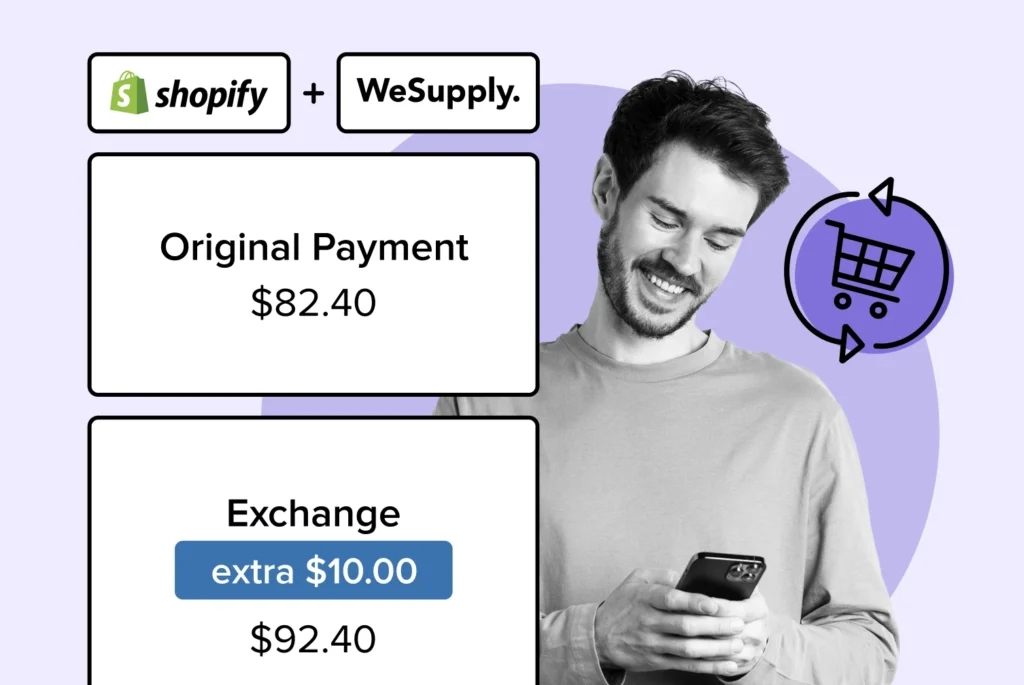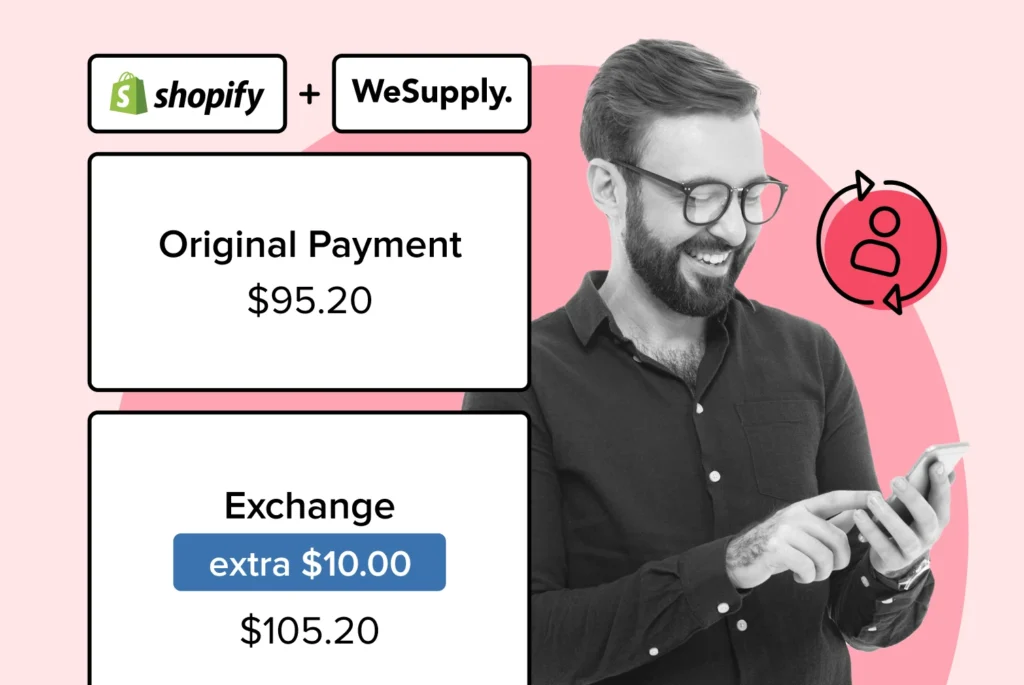
Boost Profits with eCommerce Exchanges: 12 Effective Ways
Explore the 12 key benefits that illustrate why emphasizing exchanges over refunds can be a transformative strategy for your online store!
Shipping, Tracking & Notifications
Boost customer experience and reduce support tickets
Realtime order and shipment tracking
Proactive order and shipping notifications
AI-Enhanced Discounted Labels
Predictive pre-purchase estimated delivery dates
Self-Serivce branded order tracking
Effortless experience delivered
Identify and Resolve Order Issues
Realtime order and shipment tracking
Make returns profitable and delight customers
Flexibility to define any return destinations & conditions
Simplify returns for your customers and team
Incentivize exchanges over returns
Returns management made easy for your team
Returns management made easy for your team
Easy claims and smart upsells
Understand why your customers are returning
In-Store & Curbside Pickup
Unify the online and the in-store experience
Hassle-free pickup experience for customers
In-Store dashboard to keep operations streamlined
In-Store and Online orders unified
Drive foot-traffic to your stores
Shipping, Tracking & Notifications
Boost customer experience and reduce support tickets
Realtime order and shipment tracking
Proactive order and shipping notifications
AI-Enhanced Discounted Labels
Predictive pre-purchase estimated delivery dates
Self-Serivce branded order tracking
Effortless experience delivered
Identify and Resolve Order Issues
Realtime order and shipment tracking
Make returns profitable and delight customers
Flexibility to define any return destinations & conditions
Simplify returns for your customers and team
Incentivize exchanges over returns
Returns management made easy for your team
Returns management made easy for your team
Understand why your customers are returning
In-Store & Curbside Pickup
Unify the online and the in-store experience
Hassle-free pickup experience for customers
In-Store Dashboard to keep operations streamlined
In-Store and Online orders unified
Drive foot-traffic to your stores
Boost customer experience and reduce support tickets
Realtime order and shipment tracking
Proactive order and shipping notifications
AI-Enhanced Discounted Labels
Predictive pre-purchase estimated delivery dates
Self-Serivce branded order tracking
Effortless experience delivered
Make returns profitable and delight customers
Flexibility to define any return destinations & conditions
Simplify returns for your customers and team
Incentivize exchanges over returns
Returns management made easy for your team
Equip your team for precise return checks.
Easy claims and smart upsells
Understand why your customers are returning
Unify the online and the in-store experience
Hassle-free pickup experience for customers
In-Store Dashboard to keep operations streamlined
In-Store and Online orders unified
Drive foot-traffic to your stores
Find the answer to all your questions
Take a step by step trip through our functionality to see how we can improve your ecommerce processes.
Explore the most comon questions about WeSupply
Calculate the ROI that WeSupply can bring you
Read actionable articles on how to optimize your post-purchase experience and decrease support tickets
Get inspired by stories of how our customers implemented an effortless post-purchase experience
Wondering if WeSupply is a good fit for you? Read through our use cases to see how we can help you increase conversion & improve CX!
A Deep Dive into Top Companies' Order Tracking & Returns Strategy
Find the answer to all your questions
Explore the most comon questions about WeSupply
Calculate the ROI that WeSupply can bring you
Request a no strings attached review of your current shopping experience and missed conversion opportunities
Take a step by step trip through our functionality to see how we can improve your ecommerce processes.
Read actionable articles on how to optimize your post-purchase experience and decrease support tickets
Get inspired by stories of how our customers implemented an effortless post-purchase experience
A Deep Dive into Top Companies' Order Tracking & Returns Strategy
Wondering if WeSupply is a good fit for you? Read through our use cases to see how we can help you increase conversion & improve CX!

When managing an eCommerce store, determining the ideal return window is critical for balancing customer satisfaction with operational sustainability. Your return policy can profoundly influence customer loyalty, repeat purchases, and the bottom line. This article dives into the nuances of crafting a return window that aligns with your brand, product categories, and customer expectations—providing actionable strategies to optimize your return processes and mitigate costs without compromising trust.
The optimal return window for an eCommerce store varies depending on multiple factors including product types, customer expectations, and return costs, rather than one standard duration; tailoring return windows enhances customer satisfaction and strategic competitive advantage.
Transparent and fair return policies that are clearly communicated and consistent across all sales channels build customer trust and loyalty, and staff training is essential for efficient and consistent policy enforcement.
Return policies should evolve with changing market trends and consumer expectations, implementing data-driven strategies to optimize return windows and leveraging automation to enhance the efficiency of returns management while balancing fraud prevention with customer satisfaction.
WeSupply streamlines eCommerce return policies with customizable options, automated processing, and strategic analytics. Its features enable businesses to tailor return windows, implement brand-specific policies, and manage exchanges efficiently. With fraud prevention and insights into customer behavior and return reasons, WeSupply helps reduce returns and enhance customer loyalty. This approach allows for effective inventory management and a balance between operational efficiency and customer satisfaction, optimizing both profitability and the customer experience. Boost your returns strategy and customer satisfaction today. Get started with WeSupply!
Opting for the right return window goes beyond merely adhering to industry standards. It requires an in-depth analysis of brand-specific needs alongside customer satisfaction and revenue implications. While a conventional 30-day return window may seem like a safe option, it might not be the best choice for every brand.
Establishing an ideal return window is a delicate balancing act. It directly influences repeat purchases, manages return-related costs, and hence, impacts customer loyalty and profitability. A longer return window, contrary to what one might assume, can actually serve as a marketing tool to increase conversions and reduce the likelihood of returns.
Yet, thoughtlessly prolonging the return window is not the solution either. It’s about tailoring the standards to the specifics of the brand and avoiding a one-size-fits-all policy. This ensures that your return window is not just a standard policy but a strategic tool that enhances the overall customer experience, improves customer satisfaction, and contributes to your business’s growth.
Understanding customer expectations for return windows is critical in building trust, loyalty, and a positive reputation. Today’s customers expect convenience and flexibility from return policies. Free returns have become a standard expectation in online retail, and a significant portion of consumers prioritize sustainable shipping and accessible return policies when making purchase decisions.
Retailers can grasp customer return preferences and remain competitive by gathering feedback, employing return analytics, and conducting customer surveys to keep up with industry standards.
WeSupply champions a data-driven approach to meet customer expectations and enhance retailer competitiveness. Utilizing Returns Analytics, retailers can pinpoint and address the reasons behind product returns and exchanges, optimizing product offerings and processes to boost profit margins. Additionally, with tools for tracking CSAT and NPS, WeSupply empowers businesses to refine the post-purchase experience. Through feedback, analytics, and surveys, retailers can adapt to industry standards and align with customer return preferences, maintaining a competitive edge.
The nature of the products you sell significantly influences the decision on the optimal return window. For instance, electronics stores typically offer longer return windows than toy stores to allow adequate time for customers to evaluate high-value products with longer lifespans. On the other hand, fast fashion retailers may implement shorter return windows to keep up with rapidly changing trends and the need for up-to-date inventory.
Tailoring the return window to suit the product’s nature enables retailers to afford customers ample evaluation time, simultaneously safeguarding against excessive or fraudulent returns, especially when items are returned in their original packaging.
WeSupply enables retailers to assess product categories effectively by implementing brand/vendor-specific return windows. This flexibility allows for a tailored approach to the return process, accommodating the unique requirements of different products, including seasonal items. By adapting return windows to fit specific brands, retailers can align with manufacturers’ guidelines, offering a customized return experience that respects the distinct nature of each product category while maintaining control over the return process.
The costs related to returns represent another vital consideration in defining the return window. In 2022, U.S. consumers returned 16.5% of merchandise purchases, resulting in an estimated $816 billion in lost revenue for retailers. Implementing a balanced return window can help manage these operational costs, such as shipping and restocking fees.
Incorporating a restocking fee or setting limits on customer returns can further help retailers cut return costs.
WeSupply’s approach to considering return costs includes key features designed to balance customer satisfaction with cost efficiency:
This structured approach enables retailers to offer a customer-friendly return policy while strategically managing the financial implications of returns. Transform your returns strategy for success! Book your WeSupply demo now and elevate customer satisfaction.
Transparent communication of return policies can prevent customer confusion, thereby enhancing the customer experience and fostering loyalty. Offering various return options like in-store, mail-in, or third-party drop-offs can make the return process more convenient and foster customer trust. Lenient return policies that avoid strict measures, such as restocking fees or short return windows, are favored by consumers and can set an industry standard for fairness.
Creating a fair, transparent return policy with measures to curb fraud can strike a balance between deterring return abuse and sustaining customer satisfaction. However, the approach to the return strategy should not be an afterthought but should be considered with the same importance as the fulfillment strategy to manage return costs effectively and optimize the customer experience.
Transparency is instrumental in establishing trust and encouraging customer loyalty. Here are some ways to provide easy access to return policies and enhance the shopping experience:
Include return policies on checkout pages
Provide return policy information in website chat
Include return policy details in confirmation emails
Display return policy signage in-store
Using simple and understandable language to articulate return policies can avoid confusion among customers.
Offering a detailed breakdown of the refund process, inclusive of refund methods and timelines, builds trust. Thus, effective communication of return policies, especially those with a tiered structure, prevents misunderstanding and improves customer loyalty and satisfaction.
Maintaining a uniform return and exchange policy across all company outlets streamlines the process for customers and staff alike. Maintaining uniform return policies across diverse channels like websites, mobile apps, and social media helps avoid confusion and augments the customer experience.
Empowering staff with the knowledge and autonomy to manage the return process can lead to quicker resolutions and improved satisfaction for customers. By providing clear guidelines and training for staff on handling special return cases, businesses can ensure efficiency and maintain consistency in customer service.
WeSupply empowers retailers to craft return policies that build trust by offering the ability to create custom return policies tailored to their unique needs. With advanced features like smart routing rules, retailers can ensure fast and cost-effective returns, reducing operating costs. The platform is built to accommodate any return policy, allowing retailers to take control over final sale items, return window lengths, return request approvals, and more. This flexibility ensures that e-commerce logistics are seamlessly managed, fostering trust and reliability among customers by providing a clear, consistent, and fair return process.
In 2022, retailers faced an estimated loss of $816 billion as U.S. consumers returned 16.5% of merchandise purchases, including target owned brands. Yet, promoting related products during the return process can offset this loss of revenue. This capitalizes on the ‘refund effect,’ where consumers are more likely to spend money from a product refund.
Interestingly, the refund effect is most potent when consumers initially expect to keep the goods they buy, indicating that ‘Try before you buy’ strategies may not create the same effect when the refund is issued through the original payment method.
Retailers might find it advantageous to offer store credit as an alternative to a full refund. It not only encourages customers to spend more than the value of the credit, increasing overall sales, but also helps avoid losing revenue by converting returns into exchanges. In fact, refunded money feels as if it has already been lost, which makes consumers more likely to spend it across different product categories. However, care should be taken to ensure that offering store credit doesn’t harm a retailer’s reputation if customers feel compelled to continue shopping at a retailer they’re unsatisfied with.
Providing exchanges and store credit can:
Safeguard net revenue
Stimulate further shopping
Avoid reintroducing undesired items back into the inventory
Enhance the customer experience by offering a convenient option
Increase conversion rates due to reduced perceived purchase risk.
Positive experiences with exchanges can augment Customer Lifetime Value (CLV) and stimulate repeat purchases, potentially resulting in larger orders and elevated profits.
WeSupply optimizes the economics of refunds and exchanges by incentivizing exchanges over returns, aiming to save sales and boost average order values through instant store credit options. Offering refunds as store credits, gift cards, or coupon codes not only encourages repeat business but also fosters a trusting relationship with customers. Making exchanges straightforward sends customers back to your website, potentially increasing their spend. With features like using store credit or gift cards as partial payments, WeSupply increases order value and enhances Customer Lifetime Value. By leveraging these strategies, WeSupply can significantly boost ROI for retailers. Explore how WeSupply can transform your returns process and positively impact your bottom line using our ROI Calculator.
A tiered approach to return windows provides extended periods for those choosing exchanges or store credit and a more limited duration for direct refunds, fostering customer loyalty.
By categorizing customers based on their return behavior, businesses can personalize return policies for different segments, enhancing satisfaction and promoting loyalty.
A tiered system offers several benefits. Offering longer windows for exchanges and store credit can incentivize customers to remain engaged with the brand, potentially increasing customer loyalty. It may also reduce return-related costs by encouraging customers to opt for exchanges or store credit instead of refunds, keeping the revenue within the store.
An efficient exchange system as part of a tiered return policy can improve customer satisfaction and retention by demonstrating the store’s commitment to customer satisfaction.
WeSupply’s tiered system approach offers significant benefits by allowing exchanges even after the standard return window has expired, fostering customer loyalty through added flexibility. Implementing a structured return and exchange policy—returns within 30 days, exchanges up to 60 days, and replacements or warranty claims up to 90 days—enhances customer satisfaction, decreases return rates, and streamlines inventory management. This flexibility not only meets customer needs but also encourages repeat business and positive word-of-mouth, ultimately contributing to a stronger bottom line.
Incentivize exchanges over returns
Book a quick call with our experts to see how WeSupply can help you save sales through exchanges and boost the average order value using instant store credit.
Retailers often face considerable challenges due to return fraud. However, a proactive approach that prioritizes long-term customer relationships can effectively manage return fraud without negatively impacting the overall shopping experience. Streamlining the return policy enables retailers to curtail return fraud while preserving customer satisfaction.
Automated return portals offer several benefits, including:
Enforcing return policies consistently
Reducing the manual workload on staff
Preventing fraudulent returns
Improving customer satisfaction through efficiency and accuracy.
Employing dynamic multilayered control stacks for digital applications and advanced analytics tools can help counter fraudulent activities. Thorough inspection and verification protocols for returned products are essential in countering fraudulent activities. Implementing a tiered return policy with shorter return windows for refunds can deter fraud, as refunds are more susceptible to fraudulent abuse.
By simplifying a return policy, alongside automated enforcement through return portals, businesses can reduce the likelihood of return fraud while streamlining the process for legitimate customers.
Balancing fraud prevention and customer satisfaction requires a carefully crafted strategy. Here are some key steps to consider:
Implement a proactive, customer-centric approach to fraud prevention.
Communicate clearly with customers about your fraud prevention measures and how they benefit them.
Provide a seamless and convenient return process for legitimate customers.
Continuously monitor and analyze data to identify patterns and trends in fraudulent activity.
Regularly review and update your fraud prevention strategies to stay ahead of evolving threats. By following these steps, you can effectively combat fraud while maintaining high levels of customer satisfaction.
Offering at least one free return type, such as free return shipping for exchanges or store credit, can improve customer experience while safeguarding against fraud and protecting the business’s bottom line. It’s important for businesses to accept returns in a customer-friendly manner.
WeSupply integrates advanced automated returns to mitigate return fraud while ensuring customer satisfaction. Recognizing that trusted clients form the foundation of any business, WeSupply’s intelligent fraud prevention system is designed to detect and block customers attempting to exploit return policies. This includes one-time use purchases for social media or frivolous returns. Features include:
Block list customer group enabled: Keeps a curated list of known abusers to prevent fraudulent returns.
Automatically detect return policy abusers: Utilizes an intelligent system to identify and block customers attempting to exploit return policies.
Easily configure detection and management of abusers: Offers customizable settings for identifying and handling policy exploitation effectively.
Avoid refunds on non-returnable items: Ensures that refunds are not issued for items that are not eligible for return, safeguarding revenue.
These features collectively enhance the integrity of the return process, protecting retailers from fraud while preserving a trustworthy customer experience. Discover how to protect your profits and please your customers. Book a WeSupply demo today!
As the eCommerce scene changes, customer expectations adapt accordingly. It’s incumbent upon retailers to keep abreast of industry standards and tailor their return policies to align with changing market trends.
The adoption of subscription-based models across various industries has led to retailers offering hassle-free returns as part of their subscription services to boost customer retention.
Retailers must stay updated about industry standards for return windows to make sure their policies stay competitive and meet market expectations. Retailers can monitor industry standards for return windows through online research, engaging with industry associations or trade groups, and by analyzing the return policies of competitors.
Today’s consumers have evolving expectations. Over 60% of consumers find tightened return restrictions inconvenient or unfair, indicating a strong consumer desire for return policy adjustments. An increasing preference for sustainable shipping and lenient return policies reflects a shift in consumer expectations that retailers need to consider.
The influence of social media marketing has led retailers to adapt their return policies to be more customer-friendly for online purchases made through their online store, especially when products differ from their online presentation.
Insights from customer behavior data, especially pertaining to the types of products sold and the activities of the specific customer base, can guide decisions on return window durations and facilitate the customization of return policies. Utilizing predictive analytics, retailers can forecast return rates and adjust their return windows and policies accordingly to minimize losses.
Constant monitoring of returns data enables retailers to spot trends and patterns, aiding policy modifications to cater to customer needs and boost operational efficiency. Analyzing return request data in conjunction with customer purchase history is effective in recognizing loyal customers who could benefit from a more personalized return policy.
Leveraging automated systems to capture returns data enables retailers to proactively predict future customer behavior, decreasing return rates and increasing the overall customer lifetime value.
WeSupply enables businesses to gain valuable insights by analyzing return request data, helping to understand customer preferences and dissatisfaction points. By examining returns by region, understanding the specific reasons for returns, and assessing how returns impact customer lifetime value, companies can make informed decisions to enhance product offerings and customer experiences. This analysis not only identifies trends and areas for improvement but also aids in tailoring strategies to reduce returns and increase customer satisfaction, ultimately fostering a more profitable and customer-centric business.
Establishing a streamlined returns management process can enhance overall efficiency and boost customer satisfaction. Moving towards an increased number of returns processing locations closer to the consumer can lower costs and improve the customer experience.
Utilizing systems like WeSupply to automate the returns process offers the following benefits:
Consistent enforcement of return policies
Real-time analytics and reporting
Optimization of return policy
Reduction of human error in data collection
Steadier application of return policies
An automated return process maintains clear communication with customers throughout their return journey, reducing potential friction.
Establishing a procedure for escalating atypical situations or ambiguous policies to senior management guarantees equitable resolutions in exceptional instances. Good communication with customers about the reasons behind decisions on their returns or exchanges is crucial, especially in special cases, to maintain transparency and understanding.
Evereve, a prominent fashion retailer with both boutiques and an online presence, faced significant challenges in handling returns efficiently. The manual and disjointed process resulted in a lack of visibility into returns, leading to various issues such as markdowns and overwhelmed customer service teams. Their goal was to simplify the return process and turn it into an opportunity to increase sales and customer loyalty. Evereve achieved this transformation by partnering with WeSupply and integrating their technology, automating returns, and focusing on proactivity, self-service, and return flexibility. This change led to cost savings, faster and more accurate returns, and a streamlined customer experience, ultimately benefiting both the business and its customers. Curious about Evereve’s return success story with WeSupply? Read the full case study and discover how they turned returns into opportunities for growth.
Combat inconvenience with proactivity & self service
Book a quick call with our experts to see how WeSupply can help you make returns easy for your customers with a beautiful, self-service solution that makes their experience easier while also providing new ways to lower costs and earn back revenue.
The return window in an eCommerce business is not just a policy but a strategic tool that can significantly impact customer satisfaction and profitability. From understanding customer expectations and assessing product categories to implementing a tiered return approach and leveraging data, there are several ways to optimize the return window. While it’s essential to put fraud prevention measures in place, balancing them with customer satisfaction is equally crucial. By staying informed about industry standards, addressing changing consumer expectations, and leveraging data, retailers can adapt their return policies to evolving market trends and maximize returns management efficiency.
WeSupply empowers eCommerce stores to define the ideal return window that best suits their operational needs and customer satisfaction goals. By offering customizable return policies, including brand/vendor-specific return windows and a tiered system for exchanges and warranties, WeSupply facilitates a balance between flexibility for customers and control for retailers. Key features such as automated returns, fraud prevention, and insightful return request data analysis enable stores to optimize their return processes. Retailers can adjust return windows based on product type, seasonality, and customer behavior, thereby reducing return rates and fraud, improving inventory management, and enhancing customer loyalty. This comprehensive approach ensures that eCommerce stores can establish a return policy that boosts profitability while meeting or exceeding customer expectations.
Most unopened items sold by Walmart and Target can be returned within 90 days for a refund or exchange. Certain items at Walmart have shorter return windows, such as electronics (30 days) and post-paid cell phones (14 days). Target also offers a year to return or exchange certain items like registry items and Target-owned brands.
A good refund policy should clearly state a time frame for returns, typically ranging from 15 to 365 days, and require the purchase receipt.
Absolutely, WeSupply analyzes return request data, offering insights into returns by region, return reasons, and how returns affect customer lifetime value, helping you make informed decisions to improve your product offerings and customer experience.
WeSupply includes an intelligent fraud prevention system that detects and blocks policy abusers, safeguarding your business against return fraud while maintaining customer trust.
Yes, WeSupply offers the flexibility to adapt return windows to specific brands or vendors, allowing for a tailored approach that respects manufacturers’ guidelines and addresses the unique nature of certain products.
WeSupply fosters customer loyalty by allowing exchanges even after the standard return window has expired through its tiered return and exchange system. This approach offers added flexibility and can lead to increased customer satisfaction and repeat business.

Learn How To Create Successful Post Purchase Email Campaigns
Build an effective post-purchase email flow that helps you increase customer satisfaction and drive revenue growth!

Explore the 12 key benefits that illustrate why emphasizing exchanges over refunds can be a transformative strategy for your online store!

A clear breakdown of return types, their strategic advantages, and how they contribute to customer loyalty and revenue—crucial insights!

Balance your rights as a seller with customer care, leading to a seamless return experience that promotes loyalty and protects your business.

Learn how one-click exchanges function, and practical steps to integrate them smoothly into your eCommerce setup!

Cut through the fluff with direct insights into powerful incentives, streamlined processes, and technological enhancements!

Bonus credit system: transform returns into future sales, enhance customer satisfaction, and ultimately contribute to a stronger bottom line.

Simplify the return process for both businesses and customers: the functionalities and benefits of an e-commerce returns exchange portal.

Maximize revenue through intelligent exchange policies and practices: transform a simple exchange into a powerful retention tool.

Let’s learn how to harness Shopify’s exchange framework to encourage repeat purchases and minimize lost sales!